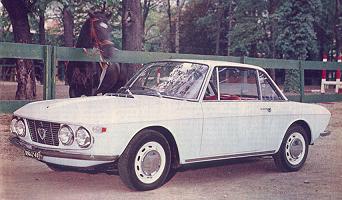 Introduced
at the Geneva Motorshow in 1963, the Fulvia was designed to replace the Appia.
Developed from the bigger Flavia, the Fulvia
used the same suspension, engine and differential layout and braking system
on a shorter wheelbase, although still with the same track as the Flavia.
An all new 13º V4 engine was developed, displacing 1091cc and producing
59bhp. The engine,
which used a cast iron cylinder block, was
tilted at 45º to aid packaging. The drivetrain
was mounted on a subframe to which was also attached the front suspension and steering.
Introduced
at the Geneva Motorshow in 1963, the Fulvia was designed to replace the Appia.
Developed from the bigger Flavia, the Fulvia
used the same suspension, engine and differential layout and braking system
on a shorter wheelbase, although still with the same track as the Flavia.
An all new 13º V4 engine was developed, displacing 1091cc and producing
59bhp. The engine,
which used a cast iron cylinder block, was
tilted at 45º to aid packaging. The drivetrain
was mounted on a subframe to which was also attached the front suspension and steering.
Late the following year the first improvement arrived
in the shape of twin carburettors and 71bhp in the Fulvia 2C.
Geneva in March 1965 saw a much more significant
addition - the coupé. Designed in-house at Lancia on a wheelbase some 150mm
shorter than the berlina, with a drag coefficient of 0.39, it used a 1216cc
engine with 80bhp. January the following year saw the coupé HF arrive now
with 88bhp and a lighter shell thanks to aluminium doors, bonnet and bootlid.
1967 saw further improvements and additions to the
range. The berlina GT arrived with the 1216cc engine and the coupé got
a new engine, with a different vee angle, displacing 1298cc and generating
87bhp. The latter model was known as the Rallye 1.3, whilst the same engine
went into the 1.3HF where it produced 101bhp, replacing the 1.2HF. Later
that year the 1216cc engine was replaced Developments continued in 1968 when the berlina GTE
with the 1298cc engine was introduced and produced alongside the already
existing 2C and GT. The Rallye 1.3S got 93bhp, later reduced to 90bhp,
whilst the most potent Fulvia ever built, the coupé Rallye 1.6HF was released
with a 1584cc 11º V4 engine producing 115bhp. An option was also available with 132bhp.
Going back to 1965, Zagato introduced their version,
the Sport. This used a coupé floorpan and mechanicals with an all new all
aluminium body, the 1216cc engine with 80bhp and a mix of coupé (dashboard)
and new (seats) interior. The mechanicals changed in line with the coupé,
1967 saw the 1298cc (87bhp) engine arrive in the Sport 1.3, the 93bhp engine
then arrived in the Sport 1.3S The second series Fulvia was released in 1969 and
replaced all the berlina models. It was mechanically the same as the GTE
model, but with a wheelbase 20mm longer, modified external styling and
a much improved interior. It was followd in 1970 by the series II coupé
which gained a five speed gearbox and a few detail design changes. The 1300 and 1600 engines continued.
1973 saw the arrival of the coupé 3, which was only
available with the 1298cc engine and which continued until production ceased in 1976.
See our Concepts page
for a picture of the Sport based Fulvia Spider
and the Ghia Fulvia Coupé.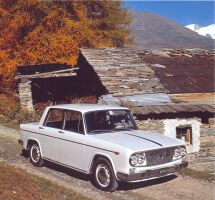 throughout
the range by a 1231cc variant of the new 1298cc engine.
throughout
the range by a 1231cc variant of the new 1298cc engine.
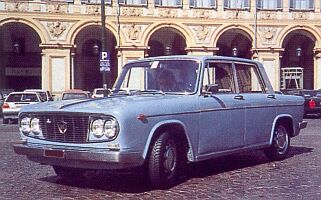 (and
was later derated to 90bhp as in the coupé) and then the 1584cc (115bhp)
engine arrived in the Sport 1600. After only a few hundred Sport 1.3's
had been built the bodyshell switched to steel, only the doors and bonnet
remaining in aluminium, and these later (in 1971) switched to steel as
well. Production finished in 1972 after about 7,100 cars had been built.
(and
was later derated to 90bhp as in the coupé) and then the 1584cc (115bhp)
engine arrived in the Sport 1600. After only a few hundred Sport 1.3's
had been built the bodyshell switched to steel, only the doors and bonnet
remaining in aluminium, and these later (in 1971) switched to steel as
well. Production finished in 1972 after about 7,100 cars had been built.
Technical Details
| Driveline | longitudinal V4 engine at front with front wheel drive |
| Engines | 818.000 : 1091cc (72x67mm) 12.9° V4 with 59bhp @ 5,800rpm
also : 818.100 with 71bhp @ 6,000rpm 818.130 : 1216cc (76x67mm) 12.9° V4 with 80bhp @ 6,000rpm also : 818.140 with 88bhp @ 6,000rpm 818.202 : 1231cc (75x69.7mm) 12.8° V4 with 80bhp @ 6,000rpm 818.282 : 1199cc (74x69.7mm) 12.8° V4 with 79bhp @ 6,000rpm 818.302 : 1298cc (77x69.7mm) 12.8° V4 with 87bhp @ 6,000rpm also : 818.303 with 90bhp @ 6,000rpm and 818.340 with 101bhp @ 6,400rpm 818.540 : 1584cc (82x75mm) 11.3° V4 with 115bhp @ 6,200rpm (132bhp @ 6,600rpm available) Click here for a cutaway of the engine. |
| Suspension | front : double wishbone with transverse leaf spring and telescopic dampers plus anti-roll bar
rear : dead axle with leaf springs and telescopic dampers wheelbase : 2480mm (berlina srs I); 2500mm (berlina srs II); 2330mm (coupé & Sport) front track : 1300mm (berlina srs I); 1390mm (coupé Rallye 1.6HF) rear track : 1280mm (berlina srs I);1335mm (coupé Rallye 1.6HF) |
| Brakes | discs on all four wheels (two piston or four piston units at the front)
split hydraulic circuit (except early cars) servo assistance on some models handbrake operating on the rear (early cars with separate callipers on disc, later cars with integral drum) |
| Gearbox | 4 speed manual
5 speed manual |
| Steering | Worm and sector |
| Kerb weight | 1030kg (early berlina); 1060kg (late berlina)
960kg (coupé) 915kg (early Sport); 960kg (late Sport) |
Performance
| model | max speed | 0-100kp/h | standing km | braking from 100km/h |
| Fulvia (1963) | 141 km/h | 27.8 sec | 43.59 sec | 60.0 m |
| Fulvia 2C (1965) | 148 km/h | 16.9 sec | 38.0 sec | 51.5 m |
| Fulvia Coupé (1966) | 160 km/h | 14.0 sec | 35.65 sec | 58 m |
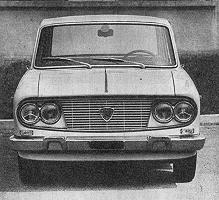
|
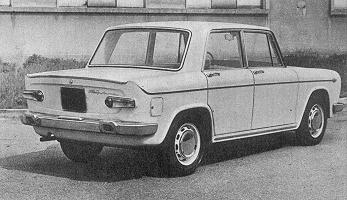 |
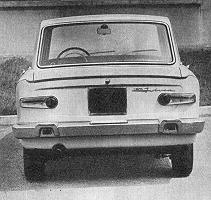 |
Identification
Berlinas
| Model No. | Details | Engine No. | Variants |
| 818.000 | original 1963-64 | 818.000 | 818.001 rhd |
| 818.100 | 2C, 1964-69 | 818.100 | 818.101 rhd |
| 818.200 | GT, column change, 1967-69 | 818.130 (818.202 from late 1967) | 818.201 rhd |
| 818.210 | GT, floor change, 1967-69 | 818.130 (818.202 from late 1967) | 818.211 rhd |
| 818.282 | GT Greece, column change, 1967-69 | 818.282 | |
| 818.292 | GT Greece, floor change, 1967-69 | 818.282 | |
| 818.310 | GTE, 1968-69 | 818.302 | 818.311 rhd |
| 818.610 | 2nd series, 4 speed, 1969-71 | 818.302 | 818.611 rhd |
| 818.612 | 2nd series, 5 speed, 1970-72 | 818.302 | 818.613 rhd |
| 818.692 | Greece 2nd series, 4 speed, 1969-70 | 818.282 | |
| 818.694 | Greece 2nd series, 5 speed, 1970-72 | 818.282 |
Coupés
| Model No. | Details | Engine No. | Variants |
| 818.130 | 1.2, 1965-69 | 818.130 (818.202 from 1967) | 818.131 rhd |
| 818.140 | 1.2 HF, 1966-67 | 818.140 | 818.141 rhd |
| 818.330 | Rallye 1.3, 1967-69 | 818.302 | 818.331 rhd |
| 818.360 | Rallye 1.3S, 1968-70 | 818.303 | 818.361 rhd |
| 818.340 | Rallye 1.3 HF, 1968-69 | 818.340 | 818.341 rhd |
| 818.540 | Rallye 1.6 HF, 1969-70 | 818.540 | 818.541 rhd |
| 818.630 | 1.3S 2nd series, 1970-76 | 818.303 | 818.631 rhd |
| 818.740 | 1.6 HF Lusso, 1970-73 | 818.540 | 818.741 rhd |
Sport (Zagato)
| Model No. | Details | Engine No. | Variants |
| 818.132 | 1.2, 1965-67 | 818.130 | 818.133 rhd |
| 818.332 | 1.3, 1967-69 | 818.302 | 818.333 rhd |
| 818.362 | 1.3S, 1968-70 | 818.303 | 818.363 rhd |
| 818.650 | 1.3S 2nd series, 1970-72 | 818.303 | 818.651 rhd |
| 818.750 | 1.6, 1971-72 | 818.540 | 818.751 rhd |
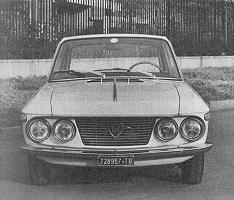
|
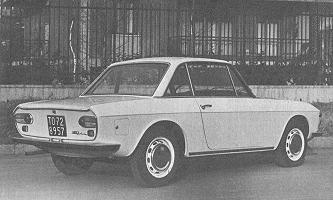 |
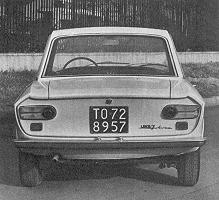 |
For more pictures of Lancia Fulvia's in action, see our Silver Flag, Trofeo Lumezzane and Giro Storico di Lombardia picture galleries.
Links
A Lancia Fulvia website
The Trento Lancia Fulvia Club website
A Lancia Fulvia Sport racecar website
One mans Lancia Fulvia resoration story.
The Fulvia Team Berlin website
The German Fulvia register website
A German Fulvia restoration website
Another Lancia Fulvia website
A useful Fulvia technical question and answer website
A Fulvia Sport website
A Fulvia 3 Coupe website including scanned owners manuals (in Italian).
Desktop wallpapers
Click on the correct screen resolution for you computer and the picture will open in the window. You can then
right click and set as desktop.
If you require a different size of picture
for your monitor please E-mail
us and we will send you the correct size.
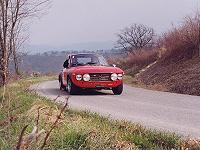
1024x768 pixels |

1024x768 pixels |
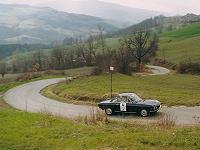
1024x768 pixels |
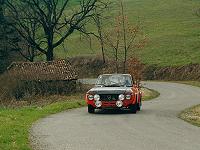
1024x768 pixels |
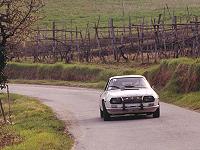
1024x768 pixels |
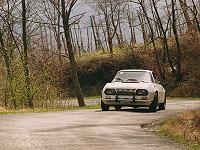
1024x768 pixels |
See also our Wallpapers/Desktop Backgrounds page.
Lancia Fulvia Books : buy them online here (in association
with Amazon)
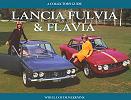 Lancia Fulvia & Flavia : A collectors guide
Lancia Fulvia & Flavia : A collectors guide |
Wim Oude Weernink |
 Lancia
Road Test Book : Lancia Fulvia Gold Portfolio 1963-76 Lancia
Road Test Book : Lancia Fulvia Gold Portfolio 1963-76
50 articles on the berlina, 2C, GT, GTE, S2, Zagato, Rallye, Lusso and Sport. Over 300 illustrations. |
Edited by R.M.Clarke, 1992 |
For more books Lancia's, see our Online Bookstore
Buying
There are still many examples of the Fulvia (the Coupé is more common) around and prices are
very low (except for the HF models). It is a robust, technically competent and good handling classic car which can be
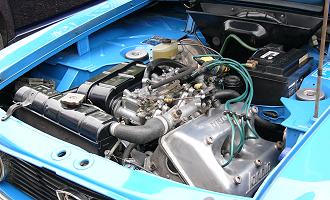 bought for very little money and used every day.
bought for very little money and used every day.
A few things to look for when considering buying a Fulvia :
1. The front subframe. Check for corrosion, especially near the rear attachment points.
2. The fuel tank. Check for corrosion on the top surface, under the carpet in the boot.
3. Check for the lack of even small pieces of chromework. In some markets these can be difficult to find and expensive to replace.
4. Check the body for corrosion, especially around the jacking points and door pillars.
Other small things to check (which can be difficult or costly to repair) are the carburettor mounting flange (the rubber
piece between the carburettors and inlet manifold), the headlight/indicator column switch, the amount of noise from the timing chain and
the functionality of the handbrake (which has a small drum inside the rear discs).
Fulvia comment form
Your Comments
This car is absolutely wonderful to
drive. The engineering and balance inherent in the true Lancia design are
outstanding. Remarkably it is also a very straightforward design that is
quite easy to work on. I adore my car. (MLK - Philadelphia, PA, USA, 1968
Fulvia Rallye 1.3 S1 Coupé)
Fulvia Series II (1973) was one of
the most enjoyable cars I've owned (I kept it for 6 years and was persuaded
to sell it to a friend).
It never let me down. It always
behaved impeccably on the road, despite being chucked around corners far
too fast most of the time, and cost very little in maintenance and running costs.
Main job (every two years) was to
free off the drum handbrake mechanism (you need a big castle spanner and
a four-foot lever!) It also needed timing chains replaced at the
proper intervals, or they flap about. I never had to remove the cylinder
head in 125,000 miles of rapid driving. (Tony W, UK)
![]() There is also a list of all our picture galleries (including museums, motorshows and various events).
There is also a list of all our picture galleries (including museums, motorshows and various events).
See also our Lancia advertisements gallery, where several adverts can be seen.
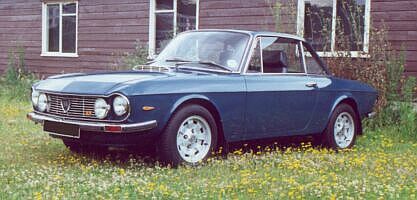
Use the buttons at the top to navigate further, or
Copyright © 2000 to 2008 CarsfromItaly